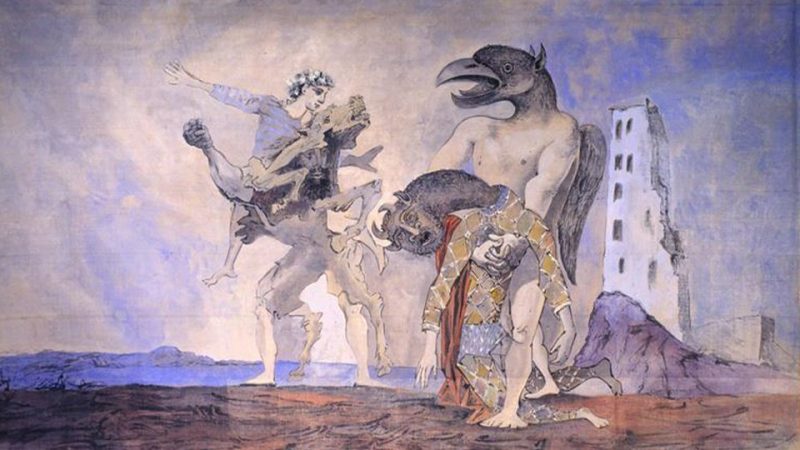
The stage curtain by Picasso
The Remains of the Minotaur in Harlequin costume
Pablo PICASSO
in collaboration with Luis FERNANDEZ
“The Remains of the Minotaur in Harlequin costume”
[La dépouille du Minotaure en costume d’Arlequin]
Stage curtain for the play Le 14 juillet by Romain Rolland
May - July 1936
In May 1936, Pablo Picasso (1881-1973) was asked to create a large curtain for the event celebrating the first “July 14th” since the Popular Front came to power. The curtain was to serve as a backdrop for an act in Romain Rolland's play Le 14 Juillet, to be performed at the Alhambra theater in Paris.
This commission follows Picasso's many collaborations with the world of the stage between 1917 and 1924. Although he worked only once for the theater, with Cocteau's Antigone (1922), he designed large-scale sets for several ballets, the best-known of which was Parade (1917). This time, with only a short deadline to create the curtain, the artist chose to use a small gouache produced a few months earlier as a model. The monumental canvas was completed in time for the show, thanks to the talent of his painter friend Luis Fernández (1900-1973), to whom he entrusted the enlargement of his model.
The curtain remained in the Parisian theater for several years and was used as a backdrop for several performances of Spanish plays and dances, before being saved from destruction by the poet Louis Aragon, who brought it back to the artist's studio.
A stage curtain in a museum hall?
In 1965, curator Denis Milhau organized a major exhibition at the Musée des Augustins in Toulouse, showcasing Picasso's work for the circus, music, dance and theater. At the end of the exhibition, Picasso donates the curtain to the City of Toulouse. The painting was then stored at the Musée des Augustins for several decades.
Quickly made on fine cotton with light paints, the curtain was damaged during this period of storage. In 1994, a BNP Paribas sponsorship financed the restoration of the work, which was carried out in aerospace hangars.
In June 2000, it was installed in the large basement room at Les Abattoirs, specially designed to house this monumental work. The architects took up the idea of a theater's configuration: a view from above (paradise), a view from a balcony, like a dressing room, staircases serving as tiers facing the stage, and the curtain at the back of the stage.
The fragility of the Curtain, due as much to the speed with which it was made as to its technique and considerable weight, means that it has to be put to rest in order to be preserved for future generations. Regularly, it lies on a sloping surface sheltered from the light, just behind the large sliding doors at the back of the room. It never leaves the room, but simply hides behind the wall...
This work is accompanied by a tactile device for the visually impaired.
Painted in collaboration with Luis Fernández, after a gouache by Picasso
Protein glue tempera on unbleached cotton canvas
830 x 1325 cm; 27 kg
Gift of the artist in 1965
Acquired for the Musée de peinture et de sculpture, known as the Musée des Augustins, in 1965
Deposited with the Abattoirs in 1995 (Inv. : D.1995.4.1 )
